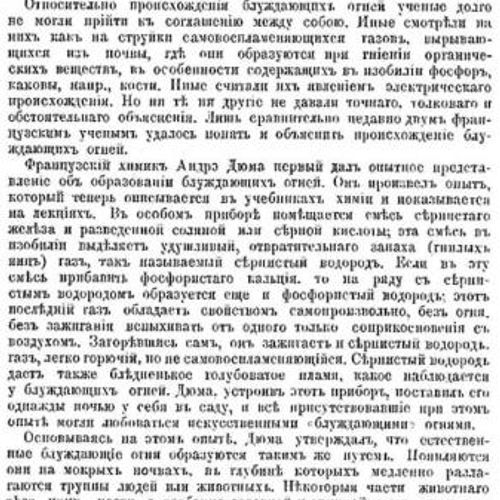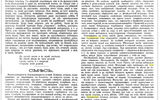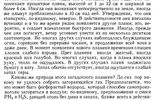
| Added | Thu, 19/09/2019 |
| Источники | |
| Феномены | |
| Версии |
In almost all parts of the world since ancient times there are various legends about the appearance of phenomena like the descriptions on the Stray lights. In many modern sources still refer to unexplained phenomena, often ascribing lights intelligent behavior and even aggression against people.
Despite this, at the beginning of XX century, many scientists believed the phenomenon is explained.
We give here the text of the article from the magazine "Niva", published in 1913:
The origin of the stray lights.
Pale lights flashing in cemeteries, swamps, wet meadows it alone, then groups popular legend believes the souls of children dying unbaptized.
German popular opinion is being demonic and insidious, trying to charm people, to harm them, for example, down the road, give a false indication, etc.
The name "wandering", these lights have already received subsequently, when people began gradually to protect against old superstitions: they are called wandering because they always seem to be moving, moving from place to place
One of the first serious observers and researchers of floodlights was a famous astronomer Bessel. He could clearly see the lights in the swamp in Bremen (Germany) in December 1807. It was in the rainy and cloudy weather. The lights were blue, but so faint that it almost did not covered the ground on which flashed, and appeared at a distance of several paces from each other. Each of them burned for approximately twenty seconds, then went out, and in a new place flashed a new one.
The testimony of Bessel is the first indication of serious and worthy of human faith, really personally seen wisps and confirmed that they actually exist and are not the result of creative folk imagination.
After Bessel stray lights were the subject of study for many naturalists that they have personally observed and described in detail. Almost all of them unanimously asserted that the motion of these "wandering" lights, which they got its title, may not be considered. The impression of wandering arises from the fact that they are in one place off, and in another flash. From this, and it seems that they jump from place to place.
Regarding the origin of floodlights scientists could not agree among themselves. Some were looking at them as a trickle snowspeeders gas escaping from the soil where they are formed during the decay of organic substances, in particular containing abundant phosphorus, what, for example, bones.
Others felt their phenomenon of electric origin. But neither those nor others did not give accurate , intelligent and comprehensive explanation. Only recently, two French scientists were able to understand and explain the origin of the stray lights.
French chemist andré Dumas was the first to give an experienced view on education of floodlights. He made the experience that they describe in the textbooks of chemistry and show in lectures. Special instrument fits a mixture of iron sulfide and dilute hydrochloric or sulfuric acid. This compound is abundant produce asphyxiating foul smell (rotten eggs) gas, called hydrogen sulfide. If to this mixture add phosphorous, calcium along with sulfur dioxide is formed and hydrogen phosphorous hydrogen. This latest gas has the property of spontaneously, without fire and spark to erupt from the contact with air. Blushing himself, he kindles and hydrogen sulfide, the gas is easily flammable, but it is not self-igniting. Hydrogen sulfide also gives a pale bluish flame which is observed in wandering lights.
Dumas configuring this device, installed it one night in my garden and all the participants in this experiment could admire the artificial "wandering" lights.
Based on this experience, Dumas argued that the natural stray lights formed the same way. They appear on wet soils, the depth of which is slowly decomposing corpses of people and animals. Some parts of the body, especially bones, the brain and spinal cord, contain in their composition of sulfur and phosphorus. the decomposition of these substances are formed of the hydrogen compounds of sulphur and phosphorous, i.e., the one combustible and samovosproizvoditsja gas mixture, which Dumas artificially staged in the garden.
Research Dumas was brought to an end another French chemist Mestrallet. In October 1905 he began a series of experiments on the marshes near Rouen, where sometimes observed the appearance of floodlights. Mastrelli he watched these lights for a whole hour. He carefully noted the place in the swamp, where they broke out. The next day he made an excavation on the spot and at a depth of 4 feet (2.8 m) found a rotten corpse of a deer. The corpse was removed from this place and after then never saw wandering lights.
After this incident, Mastrelli for the clarification of the origin of the stray lights started to test experiments. Peat bog near Versailles, he buried the corpse of the fallen cow and instructed the guard who lived nearby field every night to keep an eye on this place whether or not it lights. Three years have passed since the placement there of the body of a cow, and here in the summer of 1909 in the place appeared wisps , which were especially numerous in hot and dry time.
Mastrelli dug up the corpse of a cow and moved it to another place, ustavshie 50 yards (91,4 m) from the first. Then the old place, the lights stopped, and began to appear at the new location.
Despite the persuasiveness of the experiences Mastrella, not all of his fellow scientists had believed his findings support the conclusions of Dumas. Especially persistently argued with him in Paris physicist Lorman. Last buried the brains of several dozen head of cattle in the marsh soil. Less than a year, as he personally managed to confirm that Dumas and Mestral were right on the spot where was buried the brain, began to appear stray lights.
Thus, the account of the beginning of XX century explain the phenomenon of floodlights spontaneous combustion of gaseous hydrogen phosphide and methane formed during the decay of dead plant and animal organisms.
This is the most common explanation for the occurrence of floodlights, but this phenomenon of many other probable causes. As the simplest example, ordinary flight of a Firefly, taken in the woods behind a wisp.
Probably phenomena different from the above explanation, is considered not present (false) wandering lights.
Translated by «Yandex.Translator»
Since ancient times, there have been various legends in almost all corners of the world about the appearance of phenomena similar in descriptions to Will-o'-the-wisps: pale lights flashing in cemeteries, swamps, wet meadows, either alone or in groups. Folk legend sometimes attributes reasonable behavior and even aggression towards a person to fires, often considering them to be restless spirits, for example, the souls of children who died unbaptized. But the French chemist Andre Dumas was the first to give an experimental idea of the formation of will-o'-the-wisps back in 1905. He experimentally found out that they are spontaneous combustion of gaseous phosphorous hydrogen and methane formed during the rotting of dead plant and animal organisms.
Log in or register to post comments






